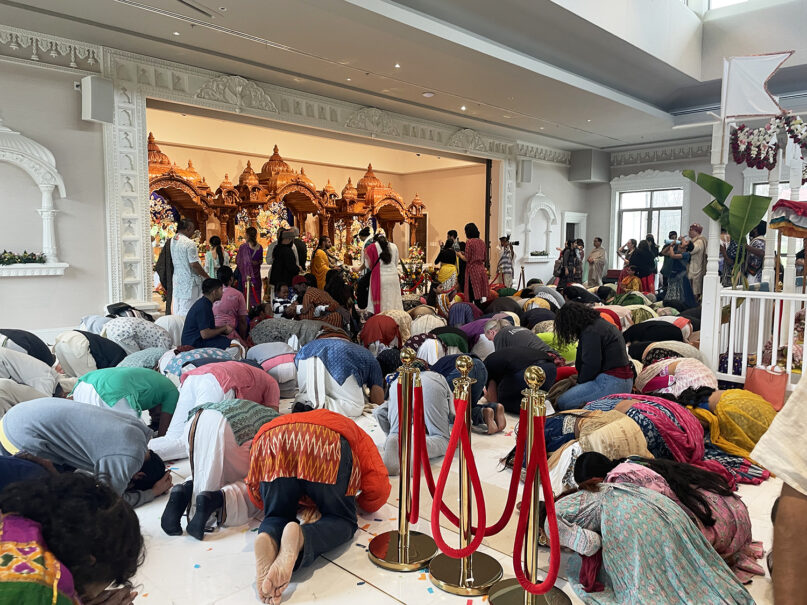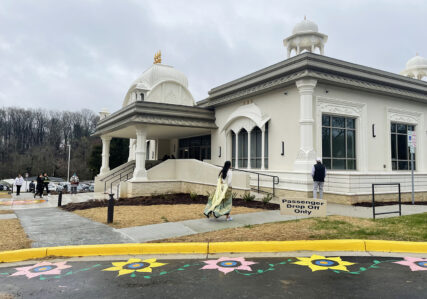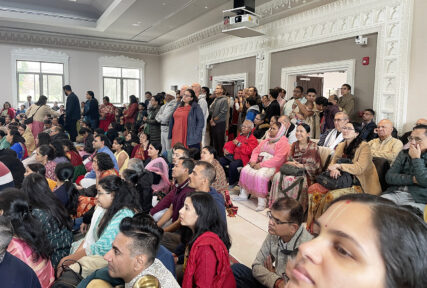POTOMAC, Maryland (RNS) — Aryan, a member of the gleaming ISKCON temple that was dedicated Saturday (March 23) in this prosperous suburb north of Washington, takes pride in the prominence the new building gives to his Hindu community, still mostly known as Hare Krishnas and satirized as a drum-banging, chanting “cult.”
“Before, the temple was down there, it was too far, you couldn’t see that from the street,” said Aryan, 18, who uses only his single initiated name given to him by his guru. “Now, this big grand temple with three domes, this big white building is just right out front on Oaklyn Drive, where so many people drive down day in and day out. For this community, it’s like a breath of fresh air.”
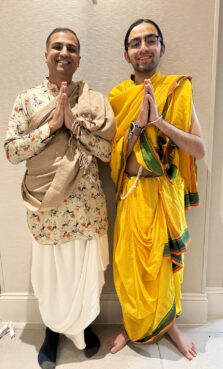
Initiates Mohan and Aryan, right, stand for a portrait during the the unveiling event. RNS photo by Richa Karmarkar
The new temple, an 11,000-square-foot marvel, opened just in time for the 50th anniversary of the Washington area’s community of the International Society for Krishna Consciousness, as the group is formally known. Coinciding with Gaura Purnima, or “Golden Full Moon,” one of ISKCON’s high holidays, the temple opening drew thousands of devotees to celebrate the achievement of the oldest Hindu group in the region.
Hare Krishnas have a long history in the nation’s capital, dating back to the movement’s participation in anti-Vietnam War demonstrations. Tom Morrison, whose initiated name is Anuttama, first encountered the group at an anti-war protest in Washington in 1971. ISKCON had formed just five years before, when a few mostly Caucasian, formerly Jewish and Christian peace lovers in New York began following the teachings of founder A. C. Bhaktivedanta Swami Prabhupada, a traveling Hindu monk.
Morrison soon donned their distinctive yellow-orange robes, shaved his head and fixed the white marking known as a tilak to his head. Taking a vow of poverty, he traveled with companions to evangelize in Miami, England, Cairo and India — where he met his wife. He was among the first residents of the D.C.-area ashram.
Today, the group has branches in over 100 countries, all major cities and more than 600 temples and farming communities around the world.
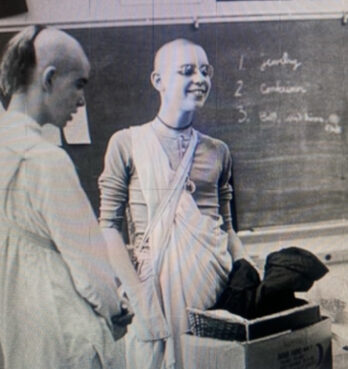
A young Anuttama, or Tom Morrison, laughs in a classroom during his high school years. Photo courtesy Anuttama
“Krishna Consciousness goes beyond any time, place or circumstance,” said Anuttama, who called the Christianity of his youth a “religion without all the answers.” “We learn that we’re eternal, and that everything is temporary in this life. When you get into that mood, when you want to surrender to God, all other things are not important. It’s a big burden taken off.”
At Saturday’s dedication, Anuttama Dasa, director of ISKCON’s international communications, told the crowd that despite the brokenness of the world, they could find hope in Prabhupada’s vision for society. Based on the messages of the Hindu deities Lord Krishna and Lord Chaitanya, ISKCON’s founder taught that the material world is temporary. “We’re all actually spiritual beings, all of us. We’re not male or female or white or black or brown or Christian or Hindu or Muslim,” Dasa said. “We’re all in service to Krishna.”
As the curtains opened to reveal the idols of Krishna and Radha, confetti burst, and the crowd clamored to catch a peek, yelling “Hare Krishna” (Praise Krishna) and “Haribol” (“Chant the name of the Lord”). The first darshan, the Hindu tradition of seeing a divine object — in this case a statue of Krishna’s avatar as Madanmohan — and it seeing you, had the raucous joy of a concert.
The new temple, with a commercial kitchen, nursery, store and 4,000-square-foot temple hall, will satisfy the needs of the area’s growing ISKCON community, say devotees.
Some Indian and other mainstream Hindus, Morrison said, have been critical of ISKCON, and some ISKCON devotees even say its emphasis on evangelization sets it apart from the traditional Hindu faith. Most of the temple’s growth for a time came from American converts.
Gaura Vani, whose mother was Jewish, joined the congregation in D.C. in 1997 with his wife, a fellow “Krishna kid,” and raised their three children there. “The worship of Krishna is not exactly a religion. Krishna in the Bhagavad Gita says, ‘Abandon religion, and just surrender unto me.’ Whatever religion we may come from, or background or race or nationality, is less important than that we’re really activating our spiritual lives.”
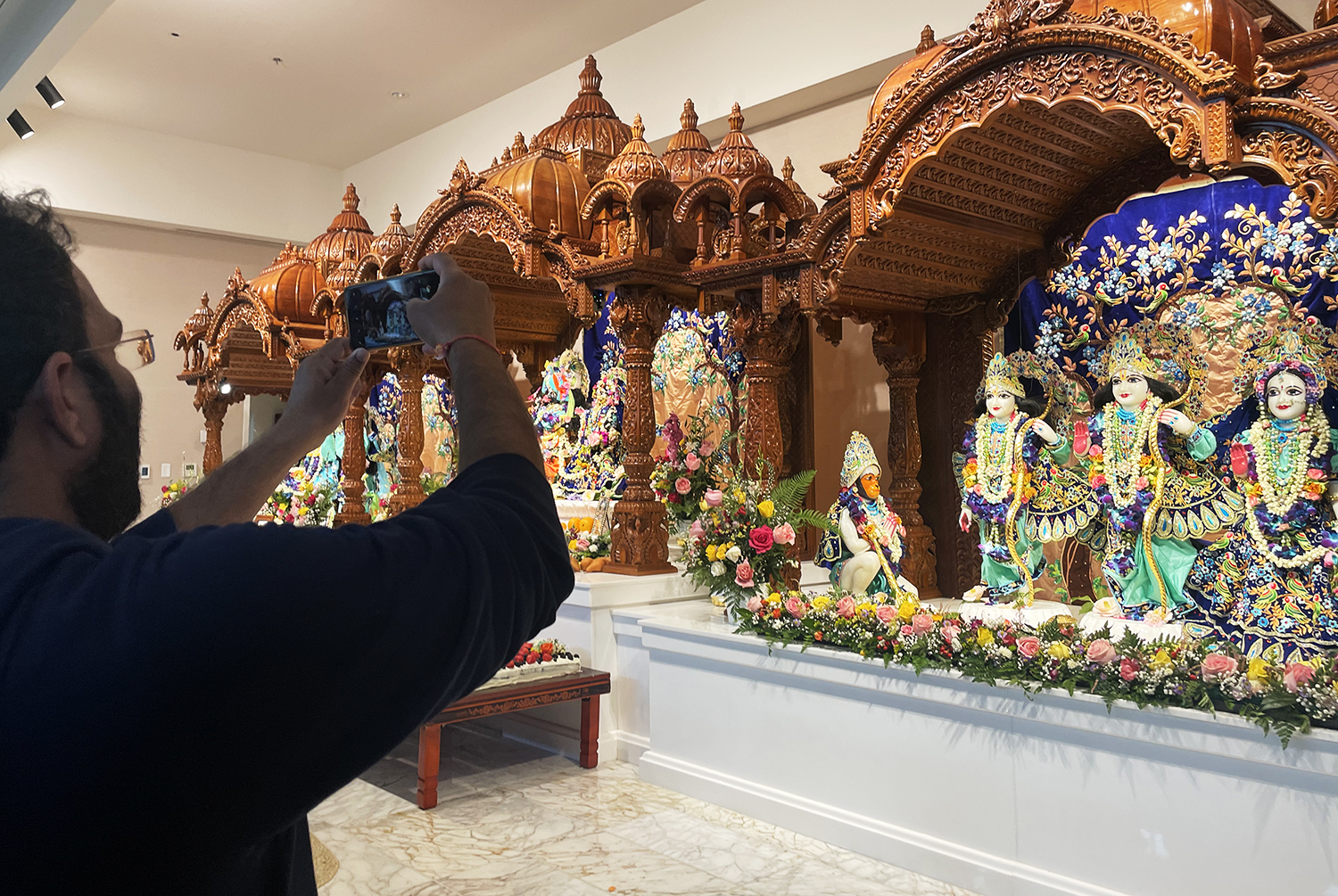
The crowd rotated around the temple and up to the front, where many photographed up close the colorful deities during the event. During the opening attendees could participate in a range of other activities including face painting, art projects and a visit to the old temple and new store. RNS photo by Richa Karmarkar
But Sonia Chopra, the communications director for ISKCON DC, whose family came to the U.S. from New Delhi, said encountering ISKCON as an immigrant to the U.S. changed her mind. “As we heard Caucasians or other people reciting the Bhagavad Gita and explaining the pure message of Bhagavad Gita and really, you know, telling us about the actual essence, it was kind of like, ‘How does he know more than I do? And I’m a Hindu,'” said Chopra.
“It made me more curious to want to really learn about my faith and learn more about Krishna. ISKCON laid such a strong foundation all around us, and really with these people who never even knew about Krishna.”
Hindus from the Indian diaspora and elsewhere, said Anuttama, were critical in the expansion of the community through their participation, but also their donations. “We would never get this $14 million building selling books on the street and at the airports,” he said. “There’s a lot of Teslas in the parking lot.”
The new temple, members say, will attract even more followers.
But it was evident from the opening celebration that much of the growth of the community will come from the young people raised at the temple.
“So many children that I’ve seen grow in this community are now growing up to become leaders,” said Chopra. “They’re becoming kirtaniyas (devotional singers), they’re fully participating. It’s exciting for me to think that this is something that we have built for our grandchildren.” She confessed she had become emotional attending the last service at the old temple the day before, thinking of her own now-grown children coming there as infants.
Youth are central to the ISKCON family, say devotees. Kirtan, the practice of collective devotional singing, keeps many youth engaged. On Saturday, call-and-response kirtans took place all day, with people of all ages tirelessly chanting the stories of God in Sanskrit.
- A newly opened ISKCON temple in suburban Washington hosted new and old members for the opening of the newly built temple on March 23, 2024. Sidewalks and parking lots were painted and activities set up for attendees to enjoy and participate in. RNS photo by Richa Karmarkar
- A packed room of attendees look on at the first unveiling of the deities from behind the curtain inside the new temple. RNS photo by Richa Karmarkar
“These kids aren’t partying; they’re not at clubs. It’s a Saturday afternoon, and they’re just, like, banging drums and clapping hands and playing violins and dancing, no drugs, no alcohol, and they’ll do it for hours and hours,” said Vani, a “minor kirtan celebrity” and kirtan teacher.
Amritha Sridhar, a 23-year-old Maryland native who was raised in the temple’s Sunday school, said she was initially saddened to hear about the new temple taking over the old. But she finds solace in the fact that the old temple will remain standing and so will the land and the congregation’s two cows, Gita and Vani.
“You don’t have to know anything — you could just sit in kirtan and feel some type of joy from it. Every person has their own connection to Krishna, you know, and no one’s judged for wherever you are in the step of that way,” she said.
Like Sridhar, Aryan said there was a bittersweet tinge in seeing the old temple retired, though the congregation had long since outgrown what was originally a typical suburban house and on festival days would line the street outside. “When I heard this temple was being built,” said Aryan, who has taken the first steps to becoming an ISKCON priest, “my first thought was, ‘Well dang, there goes my childhood!'”
